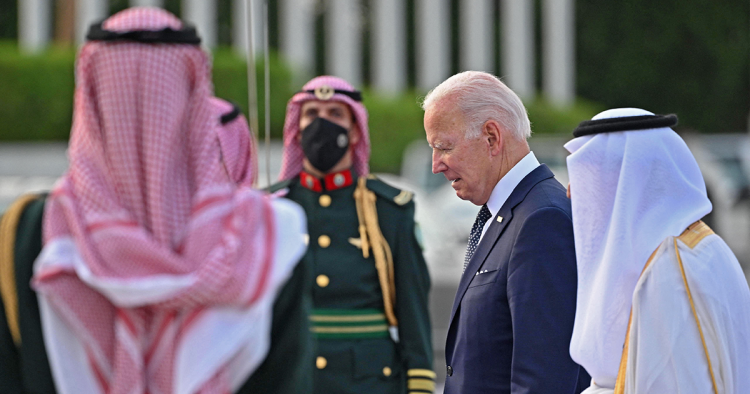As President Joe Biden and several Gulf and Middle East leaders meet in Jeddah, Saudi Arabia today, they will be discussing global energy markets, regional security, countering Iran, and building on the Abraham Accords. But in the wake of the COVID-19 pandemic, and as the Russian war on Ukraine reverberates, half of the countries in the region, and tens of millions of people, are facing desperately worsening socio-economic conditions. As the summit rearranges the higher reaches of the region’s relations, the bottom risks falling out from under several already strained societies. If the summit seeks to work toward a more stable Middle East, the U.S. and Gulf leaders should agree on a sustained effort to use part of the region’s windfall from high energy prices to support vulnerable states and societies that are at risk of serious unraveling and instability.
As the recently published UNDP Arab Human Development Report 2022 revealed, the last two and half years of the COVID-19 pandemic wiped out several years of hard-earned human development in the region. While high-income oil-exporting countries, such as those in the Gulf Cooperation Council, have managed reasonably well, the majority of Arab countries have struggled with worsening conditions, to say nothing of the plight of people in broken states such as Yemen, Syria, or Libya. Unemployment, already among the highest in the world, rose further, especially for women and youth, reaching 24% and 28.6% respectively. Poverty rates also increased and in several countries are now above 50%. In the meantime, cash-strapped governments had to widen budget deficits and take on extra public debt to respond to the pandemic, leaving them less able to confront the new challenges created by the Ukraine crisis.
The Russian war on Ukraine shows no signs of ending soon, and is likely to drag on through 2022 and beyond. The drop in the global supply of wheat has already caused critical bread shortages and price hikes throughout the region. And while energy prices have settled somewhat in the past few weeks, as the European winter approaches, an energy crunch might see oil prices soar toward new highs, with some estimating price spikes approaching $200 per barrel.
Middle-income countries in the region, such as Jordan, Egypt, Tunisia, Iraq, and Morocco, have struggled to manage the socio-economic effects of the pandemic and the Ukraine crisis so far, but will need significant support to weather the increased challenges of the next 12 months. In Lebanon, the economy has completely collapsed while the state and society are on the brink of disintegration. In Syria, Yemen, and Libya, the absence of a functioning state and the prevalence of armed conflict and banditry have made socioeconomic and humanitarian conditions among the worst in the world. All the while, some 12 million internally displaced men, women, and children, and almost 3 million refugees, continue to face desperate conditions across the region.
As the U.S. and Mideast leaders work to create a more stable and internally cooperative and integrated region, they cannot rely on a trickledown effect. Instead, they must address the bedrock of embattled human security in large swathes of the region. This is not only a humanitarian imperative, but also a political and security imperative, as desperate populations might push fragile states toward full collapse and chaos, and vulnerable communities become far more susceptible to the pull of violent extremist groups.
Several Gulf countries, including the UAE, Saudi Arabia, and Qatar, have already initiated significant government, private sector, and aid projects to Egypt, Iraq, and other vulnerable countries. Additionally, the new I2U2 grouping — that includes Israel, India, the UAE, and the U.S. — met and issued a statement just yesterday announcing new initiatives in food security, water, and other critical areas. But as the food and energy crisis deepens, much more needs to be done and in an integrated and sustained manner. And as oil exporters in the region are set to reap enormous profits from the rise in energy prices — estimated by the IMF to potentially reach $1.4 trillion over the next five years — something like an intra-regional Marshall Plan for the “other half” of the Middle East is necessary for the peace, security, and stability of the region writ large.
Every crisis presents an opportunity. As the U.S. re-engages with the leaders of the region, and as states across the Middle East move toward de-escalation of old conflicts by exploring new forms of normalization and cooperation, now is the time to imagine and work toward a more stable and prosperous future. This can only be done by focusing on the inclusion of more than half of the region’s population, which is currently on a perilously downward spiral. And as the U.S. administration looks to boost human rights in the region, it would also do well to speak out for the basic socio-economic rights of the region’s poor and vulnerable and to work with regional leaders to reverse a dangerously escalating reality.
Paul Salem is the president of the Middle East Institute. The views expressed in this piece are his own.
Photo by MANDEL NGAN/AFP via Getty Images
The Middle East Institute (MEI) is an independent, non-partisan, non-for-profit, educational organization. It does not engage in advocacy and its scholars’ opinions are their own. MEI welcomes financial donations, but retains sole editorial control over its work and its publications reflect only the authors’ views. For a listing of MEI donors, please click here.













